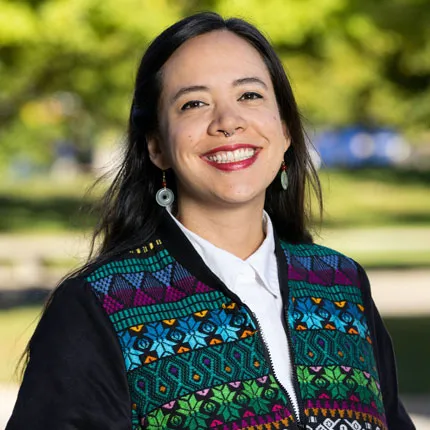
Emilia Yang is an artist, organizer and scholar. Her art practice utilizes expanded forms of digital media (XR, transmedia, web, interactive, films, archives, performance, games and public interventions) for the creation of community-based feminist, anti-racist and transformative justice projects. Her research explores the role of memory, violence, emotions, performance, and participation in the political imagination.
Who has shaped the way you show up today as an artist and/or activist?
Emilia: My art and organizing has been informed and molded by the collective pain and resistance practices of women led organizations of victims of state violence, political prisoners and feminist and LGBTQ+ groups in Nicaragua. I lived in Nicaragua under an authoritarian regime and that made me organize for my political rights, but also against police brutality because I was a victim of state violence, as the government supported paramilitaries killed my uncle.
My ancestors have also shaped the way I show up as an artist and activist. My mom, who was a keeper of an indigenous-mestiza tradition in Nicaragua, was also neurodiverse and showed me about the relationship between the psychiatric systems and gender. My uncle Vicente, who was an environmentalist and pacifist. They both taught me to love people and nature and fight for injustices.
What is the power of connecting artists working at the intersection of arts and social movements across different geographies?
My interest in decolonial feminism has helped me to see this time as a time to sustain life, to find harmony and balance, to care for others, and to care for myself, to uphold our world. As Silvia Federici states “the best form of resistance to violence is not to face it alone, it is to come together, create more collective forms of life and reproduction, strengthen our ties and thus truly create a resistance network that ends all this massacre” (Federici, 2018). I think that there is power in weaving support networks, creating recognition among ourselves as a larger community and about the issues we face collectively. I think we can learn a lot from looking at our contexts and histories in particular and explore our convergences and differences of our praxis and thinking and find common grounds for new transnational movements to emerge. Most importantly I think it is our duty to foster hope and solidarity together.
How do you see art with relation to social change and movements, toward gender justice and decolonization?
I think art is a humanizing practice, a vulnerability praxis. It allows us to translate and articulate things and materials that language sometimes fails to express, it can serve for community building, as a tool for relationality, for carving spaces that are more free and caring, it can help us orient and ground ourselves.
Art as organizing is also a world building practice and they both feed off each other. Both art and organizing can support the expansion of imaginings of change and transformation toward gender, racial, social justice and decolonization, that push back against authoritarianism, nationalism, racism, xenophobia and other forms of violence. I feel that art also allows us to grasp the complexity needed for change to occur, sometimes more than organizing, because it touches deeper on the individual interiorized experience, on process, as well as the collective experience.
